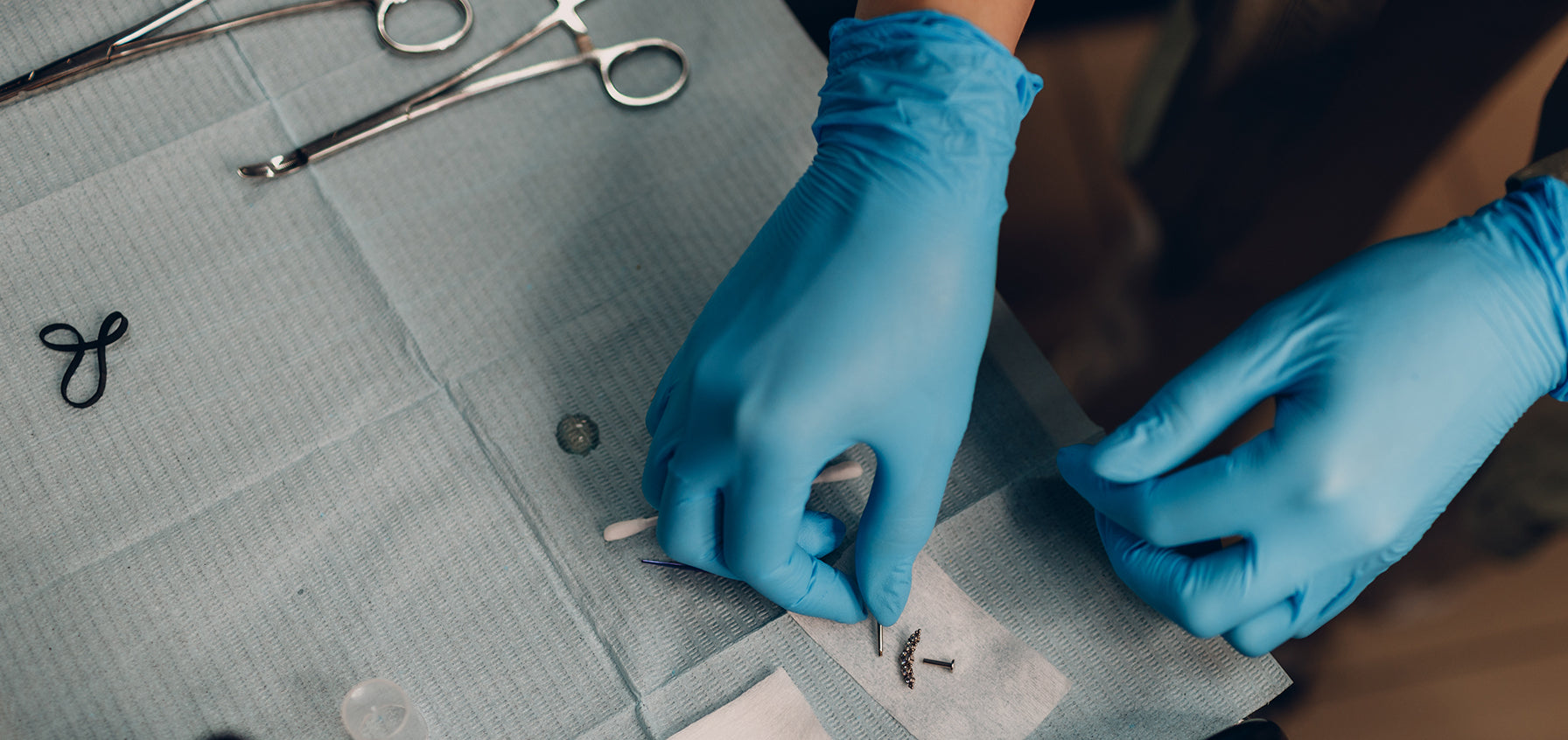
8 Tips for Talking to Teens About Piercings
Unless you’re a modified parent, talking to your child about piercings for teens can feel like stepping into unfamiliar territory. Whether it’s a simple ear piercing or something more noticeable, like a nose or belly button piercing, many teens view body modification as growing independence. As a parent or guardian, your response matters. Instead of reacting with alarm or shutting down the conversation, approaching it with curiosity, care, and clear communication can help your teen make safe, informed choices while strengthening your relationship in the process.
In this guide, we’ll share eight essential tips for navigating the topic of teen piercings with confidence and mutual respect.
Why Teens Want Piercings: Understanding the Motivations Before offering advice or setting rules, it's helpful to understand why your teen wants a piercing in the first place. One reason your teen may want to get pierced is for self-expression; piercing is a way for them to express their individuality and personality.
Getting a piercing can also be a fashion statement. These days, more and more fashion magazines and online publications are reporting about piercings being the ultimate fashion accessories, influencing teens to want certain piercings as a way to stay trendy and hip. Additionally, with an increasing number of celebrities getting pierced, your teen may be inspired or influenced by their favorite celebrity or musical artist.

Your teen could want a piercing as an act of rebellion or as a way to fit into a particular subculture. For example, if they listen to alternative music, they may want a septum or lip piercing.
Understanding the “why” behind their desire creates a starting point for a thoughtful and productive conversation rather than a heated confrontation with your teen.
Tip 1: Keep Calm and Stay Open Minded
It’s easy to feel emotional when your teen mentions body piercings, especially if it’s not something you approve of. However, showing immediate disapproval or strongly reacting could shut down communication before it even starts. Instead, take a breath, listen thoroughly to what they are saying, and acknowledge that this is important to them. Even if you have concerns, maintaining a calm, open attitude will encourage your teen to talk to you rather than hide things from you.
Tip 2: Ask Curious Questions, Not Loaded Ones
In addition to keeping an open mind, approach your teen’s request with curiosity instead of jumping to conclusions. Ask open-ended questions to gather more information before you make any decisions or judgments, such as, “What made you interested in getting a piercing?” or
“What kind of piercing are you thinking about?”. If your teen is interested in cartilage piercings, you can even show them popular types of ear piercings and have them identify which ones they’re thinking about with you.

You want to avoid asking judgemental questions. For example, do not immediately exclaim, “Why do you want to ruin your body like that?”. This type of statement can make teens defensive and less willing to engage in honest conversations.
Tip 3: Talk About Health and Safety Risks
One of the most important conversations to have with your teen before they get a piercing is about the potential health and safety risks associated with it. While piercings are generally safe when performed by licensed professionals, there are still serious risks if proper precautions are not taken or if aftercare is wholly neglected. This makes them a serious responsibility to care for if you decide to let your teen get pierced.
Begin by framing the conversation around care rather than fear. Instead of trying to scare your teen out of it, explain that you’re not against their interest in a piercing, but you want them to be informed and safe. Use calm, clear language, and say something like, “I’m not trying to talk you out of it, but I want you to understand what’s involved so you can make a smart decision.”
While a reputable piercer should discuss the pros and cons of getting a particular piercing, including the health and safety risks, here are some to know beforehand:
Common Risks to Discuss
- Infection: One of the most common complications is infection, which can occur if the piercing is not cleaned regularly or if it is touched with dirty hands. In more serious cases, untreated infections can lead to abscesses or scarring.
- Allergic reactions: Some jewelry, especially those made from nickel or cheap metals, can trigger allergic responses, leading to painful swelling, itching, or rashes. It’s best to stick with implant-grade titanium, implant-grade steel, or 14k gold jewelry.
- Oral and gum damage: Oral piercings do carry the risk of causing gum erosion, enamel erosion, and tooth decay. Some piercings minimize the risk of this damage. One of the reasons it’s so important to go to an experienced, professional piercer is that they will discuss these risks with you during a consultation. They also know how to place piercings to minimize said risks properly and suggest alternative piercings if you’re worried about said risks. Your piercer will also be aware of the risks associated with oral piercings, particularly if your teen still has braces.
- Scarring and keloids: Some individuals, particularly those with specific genetic predispositions, may develop raised scars or keloids that extend beyond the original piercing site.
- Rejection and migration: Certain piercings, such as belly button piercings and eyebrow piercings, are more prone to rejection and may leave permanent, visible scarring. This is why some piercers advise against facial piercings in teens.
Tip 4: Find Safe, Reputable Piercing Studios as a Team
If you’re unfamiliar with where people get pierced these days, your teen may try to convince you it can be done at the mall, but you should not listen to them. Instead, work together to find licensed piercers in your area. They should follow the state's piercing laws, specifically minor piercing regulations. To find a reputable piercer in your area, go to The Association of Professional Piercers (APP)’s Find a Piercer tool.
In addition to finding safe, reputable piercing studios, you also want to find out if the shops have their own age requirements for piercings. For example, a shop may not perform certain facial piercings, such as a bridge piercing, on a minor due to the potential for severe scarring.
When you do find a reputable shop you like, call them or check their website to see what paperwork you need to bring with you. In some states, in addition to parental consent for piercings, the parent or legal guardian must be present, show a form of ID, and present the teen’s official birth certificate. Shops that don’t have such stringent requirements may not be reputable. You also want to ensure that the piercer follows safe piercing practices, which means they will not use a piercing gun but instead use a sterilized hollow needle to perform the piercing.
Tip 5: Discuss Age Appropriate Decisions and Boundaries
Not every piercing is a great idea at every age, and that is okay to say out loud to your teenager. While they might feel ready for a piercing, it’s crucial to have an honest conversation about what’s appropriate now versus what might be better suited for later. This isn’t about being controlling. Instead, it’s about helping your teen make decisions that align with their level of maturity, lifestyle, and ability to handle the responsibilities that come with body modification.
One of your first boundaries can be whether your teen’s school allows them to have piercings or not. One of the first tasks you can do together is discuss the piercing and school policies around it. If the school’s dress code allows it, you can proceed to a discussion about what’s age-appropriate, what you’re comfortable with, and where you’re firm on your stance on a particular piercing.
When discussing the rest of your boundaries, be sure to explain that they aren’t about denying your teen their self-expression, but rather about ensuring they are emotionally and physically ready for what the piercing entails. Take your teen’s age into consideration. A second earlobe piercing may seem low-risk and age-appropriate for a 13-year-old. At the same time, more visible or involved options, such as a septum, eyebrow, or snakebite piercing, may require greater maturity and awareness of the long-term implications, including the potential impact on future job prospects and public perception.

Use this opportunity to establish clear and reasonable boundaries. You can turn your decision into a compromise and say, “I’m okay with an ear piercing this year, but let’s wait until you’re 17 to talk about anything on the face,” or “Once you show me you can keep your room clean for six months, we can revisit this.” Your compromise can even be that you’ll allow an ear piercing, but
you have to look at the selection of earrings together and approve which ones you will allow your teen to wear.
When you take the time to explain your thought process and you offer a future checkpoint rather than a flat-out “no,” your teen is more likely to feel respected, even if they are disappointed. Boundaries delivered with kindness and clarity are far more effective than ones delivered with frustrations or finality. Setting boundaries now helps create a foundation for future conversations, whether they involve tattoos, more advanced piercings, or other significant life decisions.
Tip 6: Explore Temporary Alternatives
If you are uncertain about letting your teen get pierced right now, suggesting temporary alternatives can be a great compromise. Teens are often driven by the desire to experiment with their appearance or feel more in control of their identity. Sometimes, this doesn’t require a permanent hole in the skin. Offering non-permanent options, such as magnetic studs, clip-on hoops, or stick-on nose jewelry, gives them a chance to try out the look without committing to something long-term.
These alternatives can serve several valuable purposes. First, they let your teen see how a specific piercing might look and feel in everyday life. Sometimes, once they see it on themselves for a few days or navigate reactions from friends, teachers, or relatives, they realize it’s not quite what they imagined. On the other hand, it can also confirm that they genuinely love the style, in which case they have taken a more thoughtful step toward their decision.
Tip 7: Make Aftercare Part of the Agreement
A piercing is a commitment, not just the moment you are getting pierced. Once the jewelry is in place, the real responsibility begins, and it can last anywhere from weeks to months, depending on the type of piercing. That’s why one of the most important conversations to have with your teen is about what happens after the piercing appointment. If your teen wants to move forward, they need to understand and agree to follow proper piercing aftercare tips every single day.
Begin by framing aftercare as a shared agreement rather than just a suggestion. Let your teen know that if you’re supporting this decision, you expect them to take ownership of the healing process. You might say something like, “If you’re ready to get this piercing, then you also need to show that you’re ready to care for it. That’s part of the deal.”
Walk them through the key aftercare expectations, which include:
- Cleaning the area twice a day with a sterile saline wound wash spray
- Washing your hands thoroughly before touching the jewelry or cleaning the piercing
- Not twisting or turning the jewelry, which can delay healing or cause trauma
- Not removing the jewelry too soon and getting appropriately downsized if needed
- Not sleeping on the piercing (especially with any ear or cartilage piercings)
- Avoiding getting makeup, lotion, or facial cleansers anywhere near the piercing
- Avoiding submerging the piercing in any public bodies of water (swimming pools, hot tubs, lakes, oceans, etc.
- Avoiding playing with the jewelry, cleaning too heavily, and causing undue trauma and friction to the piercing
- Washing and cleaning bedding regularly
- Not drying the piercing with a cloth towel
And this isn’t even everything! These are standard piercing aftercare tips recommended by the Association of Professional Piercers, and they are critical to avoiding complications such as infections or rejection.
If your teen struggles with routines or easily forgets responsibilities, this conversation becomes even more important. The ability to stick to a piercing aftercare plan is a strong indicator of whether they’re truly ready for the responsibility that comes with a body modification.
By making aftercare part of the agreement rather than an afterthought, you’re not only protecting your teen’s health but also teaching a powerful lesson about follow-through and personal responsibility. In the end, the piercing itself may be small, but the habits it requires can help shape maturity in a much bigger way.
Tip 8: Be Honest About Your Feelings, But Let Them Feel Heard
Talking to your teen about piercings doesn’t mean you have to pretend you’re totally comfortable with it, especially if you’re not. In fact, being transparent about your thoughts, concerns, or hesitations can open the door to a more respectful and honest conversation. The key is to express yourself in a way that keeps the lines of communication open, rather than making your teen feel shut down.
Start by using “I” statements to explain how you feel, rather than placing blame. For example:
- “I’m worried about how visible facial piercings might impact job opportunities or school policies.”
- “I’ve seen infections from poorly done piercings before, and I just want to make sure you’re safe.”
- “I understand that nose piercing jewelry is trendy and expressive, but I want us to make sure it’s something you’re truly ready for and not just something that you think looks cool right now.”
Framing your perspective in this way shows your teen that you’re not dismissing their interest. You’re just trying to protect them from possible consequences and help them think long-term.
At the same time, it’s equally important to actively listen to your teen’s point of view. Maybe they’ve been researching gold nose rings and studs and are excited about expressing themselves through a minimalist, classy look. Maybe they’ve seen friends wear nose piercing jewelry and feel inspired. Whatever their reason, acknowledging that their feelings are valid (even if you don’t entirely agree) goes a long way.
Try saying something like:
- “I hadn’t considered it from that angle. Thank you for explaining it to me this way.”
- “Tell me more about why this particular type of piercing feels meaningful to you.”
You might not end up on the same page, but your teen will walk away feeling heard, which is a huge win for trust and long-term communication.
When to Say Yes, When to Say No, And How to Handle Pushback
After having an open and honest conversation with your teen about piercings, you may find yourself at a crossroads: do you say yes, say no, or ask them to wait? There’s no one-size-fits-all answer here. What matters most is that your decision is thoughtful, consistent, and rooted in your teen’s best interests.
Start by considering a few key factors:
- Maturity level: Has your teen shown they can follow through on responsibilities like personal hygiene, schoolwork, or chores? These everyday behaviors are strong indicators of how well they’ll manage piercing aftercare.
- Piercing location: Is your teen asking for something relatively low-risk, like an additional earlobe piercing? Or are they interested in something more complex or visible, like a nose ring or eyebrow piercing?
- Timing: Will the piercing interfere with school dress codes, sports, job interviews, or other commitments?
- Understanding of risks: Has your teen done their research? Do they understand proper aftercare and the importance of using safe, high-quality jewelry?
If your answer is yes, make it conditional on a few non-negotiables: choosing a licensed piercer, using safe jewelry, and following all aftercare responsibilities. You can even go a step further by making a written agreement outlining expectations before and after the appointment.

If you do decide to say yes, you can even make it a bonding experience and get a piercing too. You don’t have to get the same one your teen wants, but you can turn the experience into something you share, from picking out jewelry for each other to holding each other’s hands during the piercing process.
If you decide that the timing or request isn’t right, it’s okay to say no or “not yet.” Just be prepared for pushback. You teen might respond with frustration, disappointment, or even a bit of rebellion. Stay calm and explain your reasoning with clarity and empathy. You can say things like: “I know this is important to you, but I don’t feel you’re ready for this level of responsibility just yet.” or “I’d rather wait until we can do this safely and responsibly togethr. Let’s revisit it in a few months.”
Offering a clear path forward can ease the sting of a “no.” For example, you might agree to reconsider the conversation once they’ve shown consistent responsibility or after a certain birthday.
Ultimately, your teen may not agree with your decision right away, but they’ll respect your willingness to discuss it openly and your desire to support them in a safe, informed way. Handling the conversation with empathy and structure ensures your voice is heard and sets the tone for future conversations about independence, choices, and trust.

